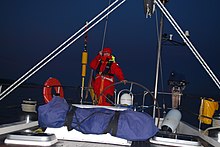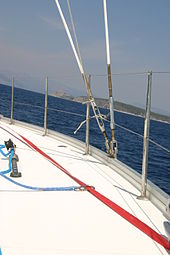Lifebelt
The harness ( Engl. Life-saving belt "life-saving belt") is a belt harness for securing sailors aboard a watercraft . It prevents falling overboard. The English word harness , which originally stands for bridle , is also used synonymously . For belt harness includes a safety line or lifeline .
Harness
The harness consists of straps that are passed under the armpits and, if necessary, under the crotch and attached to the body. There is a D-ring on the harness , to which a hook of the lifeline is attached, the other end is hooked onto parts of the ship. This picking is to prevent a person falling overboard, being washed overboard in heavy weather or falling while climbing in the rigging . Harnesses designed for use in recreational boating contain - in contrast to a climbing harness, for example - only a comparatively thin belt between the legs. This is only intended to prevent the harness or vest from sliding over the head if the wearer falls into the water. Seat belts are only required when working in the rigging. The latter is in the current normal schratgetakelten rarely necessary sailing ships and is usually done by pulling up with a boatswain's chair , not by classical aloft (climb).
Lifeline
The lifeline (Lifeline), originally a short piece of rope (short rope), is now mostly of a belt made of nylon or similar material with two or three snap hook . Models with three hooks - one at the beginning, one in the middle and one at the end - allow the pick point to be changed without ever having to completely loosen the safety device. The total length of the lifeline including hooks must not exceed 2 m.
application
Lifebelts are put on especially in heavy seas and when you are alone on board or when working in the rigging. The same recommendations apply as for wearing life jackets.
For a lifebelt to work properly, it must be correctly sized. The crotch strap between the legs must be tightened to prevent them from slipping out. The lifeline must be hooked into a safe and secure place on board at all times. Special eyelets are considered safe, mostly next to the companionway and on the mast, on the handles on the steering column and on deck, or on stretching ropes specially stretched for this purpose on deck . Shrouds and the stage can also withstand the load of one person. So that a carabiner is always securely hooked in, better models of the carabiner consist of two straps with one carabiner each. The railing wires are unsuitable as a fastening point, as you stay connected to the ship when falling overboard, but you may hit the bow hard and be pulled in the water. Any parts that are moved, i.e. traps , pods or even the steering wheel , are also unsuitable .
Life jacket with lifebelt

Today many life jackets - especially automatic ones - are equipped with an integrated lifebelt. Sometimes this is available at a small additional cost. Since both should be worn anyway in bad weather, this combination is useful and more comfortable to carry than two independent pieces of equipment. This combination is not suitable for use as a trapeze for dinghy sailing.
Norms
Lifebelts and leashes must meet the DIN EN 1095 standard. This has since been replaced by EN ISO 12401, but the products are often still labeled with the older standard. The standards are practically identical in terms of content. During the revision, particular importance was attached to the need to emphasize the wearing comfort of the safety harness. This is intended to encourage water sports enthusiasts to always wear safety equipment. The standard is not applicable to harnesses for dinghies or windsurfing boards, for safety belts in fast motor boats and for equipment that protects against falling from a great height. Classic lifebelts differ from the latter mainly in the lack of seat belts and energy absorbers .
The equipment must pass several tests in order to comply with the standard. Approved belts must have seams of a different color, so that damaged seams can be identified immediately. Harnesses for adults (> 50 kg body weight) are tested in a procedure similar to the standard fall for climbing ropes. A dummy weighing 100 kg is dropped 2 m without the belt being damaged or slipping on the dummy. The wearing comfort must also be assessed by independent testers. Belts that hinder breathing or have sharp edges fall through.
Web links
- "Lifebelt" at the Sea Rescue Association
- Complete standard (English; PDF; 296 kB)
Individual evidence
literature
- Seamanship. Handbook for yachting , Delius Klasing Verlag , Bielefeld 2008, ISBN 978-3-7688-0523-0 (28th edition now available)


